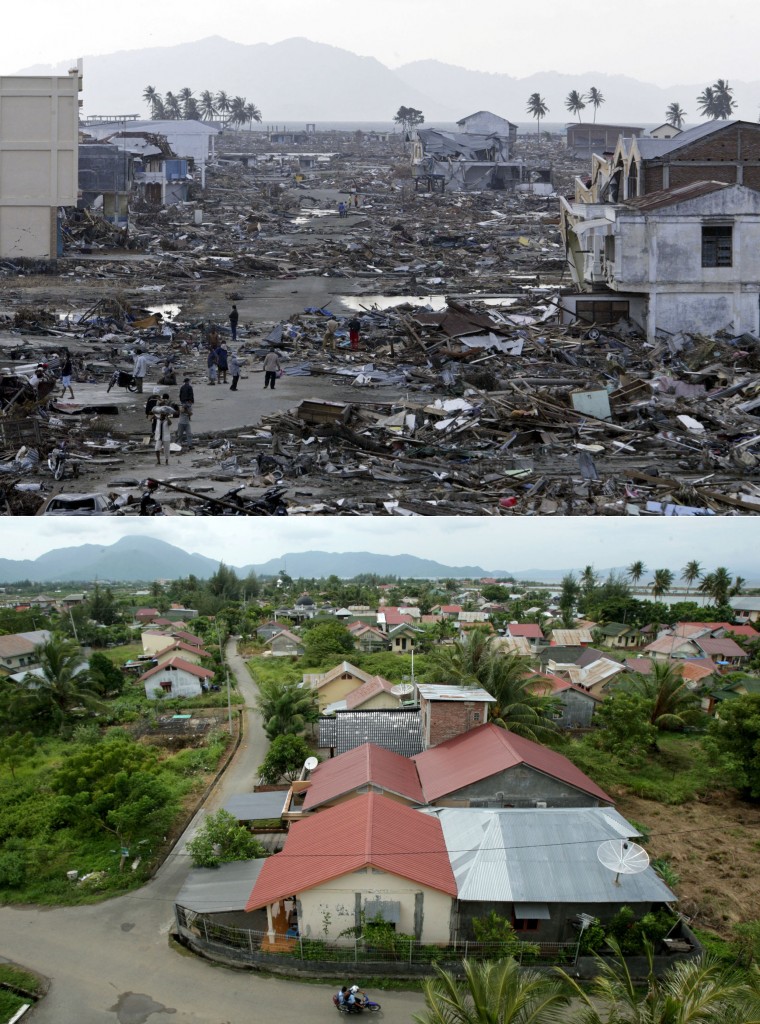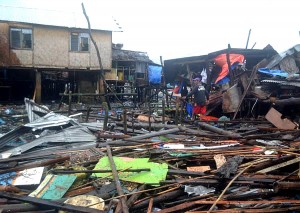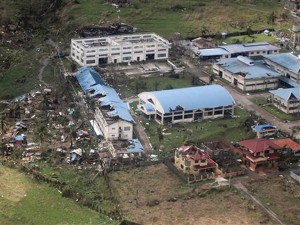From 2004 tsunami recovery, lessons for Philippines

This combination of photos shows areas affected by the earthquake-triggered tsunami which hit Banda Aceh, the capital of Aceh province, Indonesia, on Dec 25, 2004. The top photo shows a devastated area on Dec 31, 2004, six days after the tsunami. The bottom photo shows an area with rebuilt housing on Nov. 19, 2013. AP
MANILA, Philippines — The man who steered Indonesia to recovery after the 2004 tsunami has some cautionary words for the Philippines as it begins planning reconstruction after Typhoon “Yolanda”: Survivors will get angry about living in tents well before permanent houses are ready, and inflation will soon make those houses much more expensive to build.
His advice? Start working now and get survivors involved in the process.
“Please prepare warehouses now all over the region and fill them with construction materials,” said Kuntoro Mangkusubroto, who headed a specially created, powerful government agency tasked with coordinating more than $7 billion in aid that flowed to the country after the disaster. “Fix the prices now.”
The Indian Ocean tsunami killed about 230,000 people in a dozen countries. Indonesia’s Aceh province was the worst-hit area, accounting for about half the deaths. Much of the provincial capital, Banda Aceh, was leveled.
Aceh’s reconstruction didn’t always run smoothly, especially during the first year, but it is now almost universally regarded as successful. Around 130,000 houses were built in less than three years, along with scores of airports, roads and schools. It was the biggest construction project in the developing world.
Article continues after this advertisementThese days, the only sign that Banda Aceh was the epicenter of an appalling disaster are two ships carried miles inland by the giant waves. They are now popular and well-managed attractions on a “tsunami tourism” trail in the city.
Article continues after this advertisementThere are lessons to draw from the 2004 tsunami, and from more recent — and more criticized — reconstruction efforts after disasters in Japan and Haiti. The Philippines also has much experience of its own recovering from typhoons and other disasters.
A full assessment of the damage caused by the typhoon has yet to be carried out. There were far more deaths in Aceh. The Philippine government said Wednesday that the typhoon killed more than 4,000 people and left 1,600 missing. But experts say the scale of the reconstruction needed in the Philippines looks broadly comparable with that in Aceh.
Like Indonesia in 2004, the Philippines has functioning national and local governments with committed, educated employees. Foreign countries are more likely to help if they can see efforts being made to spend money well.

This combination of photos shows an area affected by the Dec. 25, 2004 tsunami which hit Banda Aceh, the capital of Aceh province, Indonesia. The top photo shows debris near the Great Mosque, background, on Dec. 29, 2004, four days after the tsunami. The bottom photo shows the same area on Nov. 19, 2013. AP
Just under two weeks since the typhoon, saving lives and providing emergency aid are still the main focus. Corpses are still being collected from beneath the debris. But in a week or two, authorities will start transitioning into an “early recovery phase” and planning how best to rebuild the estimated 320,000 destroyed houses.
“It’s never too early to start talking about it,” said Nancy Lindborg, the assistant administrator of the U.S. government’s aid arm. “What’s very important is to move as quickly as possible, so you enable people to start thinking about the future.”
Interior Secretary Manuel Roxas said authorities were already considering whether to put people in tents or bunkhouses. In Aceh, authorities built 24 wooden barrack-style complexes for survivors, but they were not popular, often located far from the original villages of the residents or their workplaces.
Aceh managed to build just 16,000 permanent houses in the first year after the tsunami. Spiking construction costs were one problem: Inflation hit 41 percent at one point as massive amounts of money chased limited supplies. Another complicating factor likely to be seen in the Philippines was that land titles and government records were destroyed.
“It was almost impossible,” said Mangkusubroto via telephone from Jakarta. “People shouldn’t have to live in tents for more than six months. It causes social tension.”

Houses made of light materials were completely destroyed by rains and wind brought by Supertyphoon Yolanda in Coron, Palawan. CONTRIBUTED PHOTO/OFFICE OF THE MAYOR OF CORON, PALAWAN
It will likely take months to even decide where to build, or what safety standards to use, because the government and affected communities will need to work together to come up with the right answers. In Aceh, authorities initially banned construction close to the sea, but this was shelved as impractical because the province relies on fishing.
“We have to make sure that these buildings are not built in unsafe areas,” said Nathaniel Von Einsiedel, the chairman of an urban development consultancy firm. “We don’t want to commit the same mistake that may have contributed to the severity of the destruction in the first place.”
The Philippine government said about $320 million in foreign aid has been pledged to the relief effort.
That’s far less than the $7 billion Indonesia received after the tsunami — the most generous response ever to a natural disaster — but that massive amount of money created its own complications.
Some of the more than 180 aid agencies that flocked to Aceh took on projects they were not qualified for or duplicated other schemes. Some families got a house they didn’t need, or in a place where didn’t want to move to. Others got more than one. Today, empty, rotting houses aren’t hard to find.
Another lesson from Aceh: Giving cash to disaster survivors, either in a grant or in exchange for projects such as cleaning debris, is effective and popular. Expect to see those schemes used widely in the Philippines. Old-school development thinking shied away from handing out money, partly out of fears it would be “squandered.” Studies by aid agencies and academics have shown that is not the case.
Success in Aceh contrasted with stuttered reconstruction efforts in Japan following the 2011 earthquake and disaster, where more than half of the 470,000 people who either lost their homes or were evacuated from close to the Fukushima Dai-Ichi nuclear plant have yet to be permanently resettled. Ample funds have gone unspent due to legal and bureaucratic obstacles to rebuilding and shortages of construction workers.

This photo released by the Malacanang Photo Bureau shows an aerial view of Tacloban city, Leyte province in central Philippines Sunday, Nov. 10, 2013, after Typhoon Haiyan ravaged the region in the Philippines. AP FILE PHOTO
The aftermath of the Haiti earthquake in 2010 has also been troubled. The capital is awash in new construction, but the International Organization for Migration says nearly 200,000 people are still living in makeshift settlements. The international community pledged $5.4 billion to help Haiti, but only about half has been delivered to date.
The Philippines is poor, but its governance structures are stronger than those in Haiti. Aid groups will have less money to spend than after the 2004 tsunami, but coupled with Philippine government funds and loans from agencies like the World Bank, many experts and aid workers are optimistic that the region will recover.
“I think it would be disappointing if we come back in four years’ time and people are worse off than what they were coming into this,” said Michael Delaney, who leads Oxfam America’s humanitarian response to emergencies.
RELATED STORIES:
‘Yolanda’ death toll now over 4,000
‘Yolanda’ revives compensation row at UN climate talks
Disaster experts warn on avoiding 2004 mistakes in Philippines